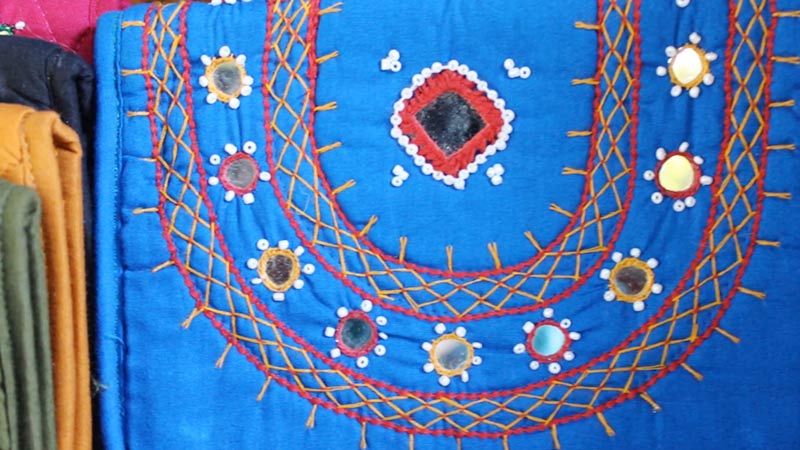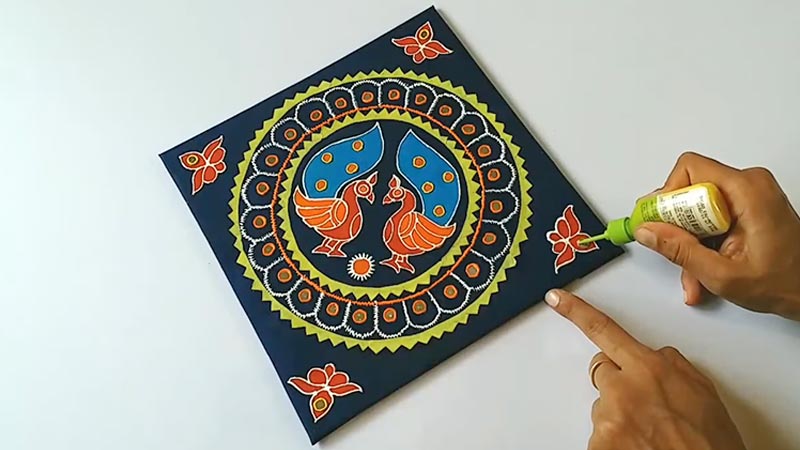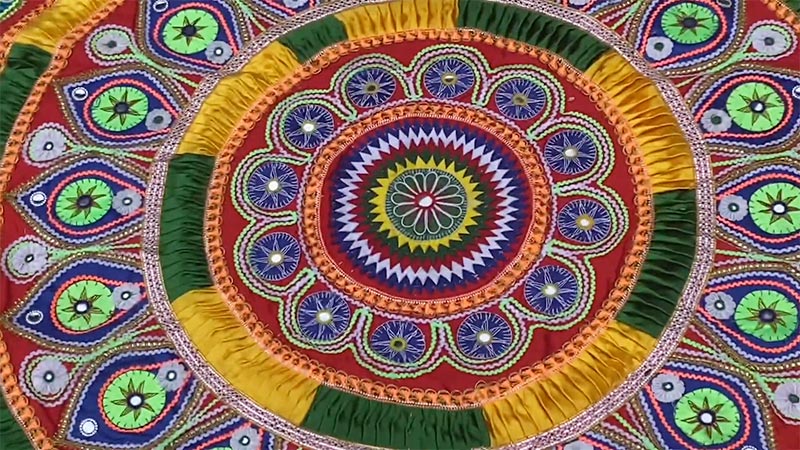Pipli embroidery, hailing from the historic town of Pipli in the Indian state of Odisha, is a captivating and centuries-old textile art form.
Characterized by its vibrant colors, intricate appliqué work, and rich cultural symbolism, Pipli embroidery is a testament to the region’s creative heritage.
This traditional craft involves the meticulous stitching or gluing of colorful fabric shapes onto a base fabric, resulting in a dazzling array of designs, including mythological figures, animals, and religious symbols.
Pipli embroidery finds its most prominent use in crafting decorative canopies and umbrellas for religious and cultural festivals, adding a burst of color and tradition to these events.

What Is Pipli Embroidery?
Pipli embroidery, also known as Pipli Appliqué work, is a traditional and vibrant form of textile art that originates from the town of Pipli in the Indian state of Odisha.
This unique craft has a rich history that dates back centuries and is an integral part of the cultural heritage of the region.
Pipli, a small town located on the eastern coast of India, is famous for its colorful and intricate appliqué work, which is primarily used in creating decorative canopies and umbrellas for religious and cultural festivals.
Key characteristics and features of Pipli embroidery include:
Colorful Designs
Pipli embroidery is celebrated for its brilliant and dynamic color palettes. The artisans use a wide spectrum of vibrant hues, such as reds, yellows, blues, and greens, often in striking combinations.
These colors not only make the designs visually captivating but also carry symbolic meanings. For instance, red is often associated with auspiciousness and prosperity, while blue might symbolize the divine.
Appliqué Technique
The appliqué technique involves cutting out intricate shapes and patterns from colored fabric and then stitching or adhering these pieces onto a base fabric. This meticulous process demands a high level of precision.
The use of both machine and hand embroidery adds depth and texture to the final product, creating a stunning visual impact.
Traditional Motifs
Pipli embroidery motifs draw inspiration from the rich cultural and religious tapestry of Odisha.
Common designs include depictions of Lord Jagannath, who is a revered deity in the state, as well as intricate renditions of local flora and fauna.
These motifs often have sacred and mythological significance, making them an integral part of the region’s cultural heritage.
Versatile Applications
While Pipli embroidery is traditionally associated with canopies and umbrellas used in religious and cultural processions, its applications have expanded over time.
Artisans now use this technique to create a diverse range of items. These can include exquisite wall hangings that adorn homes, bedspreads that add a touch of elegance to bedrooms, colorful cushion covers, and stylish bags and clothing items.
Craftsmanship
Pipli artisans are known for their exceptional craftsmanship. They are often apprentices to skilled masters and undergo rigorous training to perfect their art.
The cutting and stitching require great precision and patience, as any deviation can mar the final product.
Many artisans take immense pride in their work, often considering it a sacred duty to preserve the cultural heritage of Pipli embroidery.
Festive and Cultural Significance
Pipli embroidery plays a pivotal role in various cultural and religious festivities. The canopies and umbrellas adorned with these vibrant designs are used in processions and rituals during major Odishan festivals.
For instance, during the grand Rath Yatra (chariot festival) of Lord Jagannath in Puri, these embroidered canopies are an indispensable part of the event.
They not only provide shade but also contribute to the overall grandeur and sacredness of the festival.
Economic Importance
Beyond its cultural and artistic significance, Pipli embroidery also holds economic importance. It sustains the livelihoods of many local artisans and their families.
The craft attracts both domestic and international tourists, providing a source of income for the local community. As a result, it contributes to the economic prosperity of the region.
What Is Pipli Embroidery Used For?

Pipli embroidery is used for a variety of decorative and functional purposes. This traditional textile art form, originating from the town of Pipli in Odisha, India, has gained popularity both locally and globally due to its vibrant designs and intricate craftsmanship.
Here are some of the primary uses of Pipli embroidery:
Religious Festivals
Pipli embroidery holds a central role in the religious festivals of Odisha. During the world-famous Rath Yatra in Puri, ornate canopies and elaborately decorated umbrellas with Pipli embroidery are carried over the chariots of Lord Jagannath, Balabhadra, and Subhadra.
These colorful canopies not only provide shade to the deities but also create a visually stunning spectacle during the procession.
They symbolize the divinity and magnificence of the occasion, captivating the devotees and onlookers.
Home Decor
Pipli embroidery is a popular choice for home decor enthusiasts. Wall hangings adorned with Pipli designs add a touch of traditional elegance to living spaces, and the bright and intricate patterns inject life into room interiors.
Bedspreads featuring Pipli’s work are treasured for their artistic beauty and are often used to showcase cultural heritage within homes.
Vibrant cushion covers with Pipli embroidery can transform a room’s ambiance, making it more inviting and visually appealing.
Bags and Accessories
Pipli embroidery is creatively incorporated into a wide range of fashion accessories. Colorful, handcrafted bags, purses, and clutches with Pipli designs are popular among those who seek unique and stylish accessories.
These items not only reflect a love for traditional artistry but also make a fashion statement, showcasing a fusion of tradition and modernity.
Clothing
Pipli embroidery has made its way into clothing, particularly women’s attire. Sarees, blouses, and dresses featuring Pipli designs are in demand for their vibrant and intricate patterns.
These garments are not only visually captivating but also represent a cultural connection to the rich heritage of Odisha.
Cultural Events
Pipli embroidery plays a role in enhancing the visual appeal of cultural events, fairs, and exhibitions.
Banners, flags, and decorations with Pipli designs are commonly used to create a festive and traditional atmosphere.
These embroidered items help convey the cultural significance and artistic traditions of the region during such gatherings.
Souvenirs and Gifts
Pipli embroidered items serve as memorable souvenirs for tourists visiting Odisha. They are popular choices for travelers seeking to take home a piece of the region’s artistic heritage.
These items also make for thoughtful and unique gifts, as they showcase the rich culture and craftsmanship of Odisha.
Stage and Film Productions
The vibrant and attention-grabbing nature of Pipli embroidery has led to its use in stage and film productions.
Costumes, props, and set designs featuring Pipli work add a visually captivating and culturally authentic touch to theatrical performances and movies, enriching the storytelling experience.
Advantages of Pipli Embroidery

Pipli embroidery, known for its vibrant and intricate designs, offers several advantages, both from an artistic and cultural perspective.
Here are some of the key benefits of Pipli embroidery:
Cultural Preservation
Pipli embroidery plays a vital role in preserving the cultural heritage of Odisha, India. It embodies the region’s traditions, myths, and religious beliefs in its motifs and designs.
By continuing this art form, it ensures that these cultural elements are passed down to future generations.
Artistic Expression
Pipli embroidery provides artisans with a medium for artistic expression. They have the opportunity to showcase their creativity, skills, and unique designs. This fosters a sense of pride and satisfaction among artisans.
Economic Opportunities
Pipli embroidery supports the livelihoods of numerous local artisans and their families. It creates job opportunities in the region and contributes to the economic well-being of the community.
The sale of Pipli embroidered items in local and international markets generates income for artisans.
Versatility
Pipli embroidery is versatile and can be applied to various items, including clothing, accessories, home decor, and ceremonial items.
This versatility allows for a wide range of applications, making it appealing to different consumer preferences.
Cultural Identity
Pipli embroidery serves as a symbol of cultural identity for the people of Odisha. It is recognized and appreciated not only within India but also on a global scale. The distinct designs and motifs are a source of pride for the region.
Celebration and Festivals
Pipli embroidery enhances the beauty and grandeur of religious and cultural celebrations in Odisha.
Elaborate canopies, umbrellas, and decorations made with Pipli work add color and significance to events, making them even more memorable and visually appealing.
Tourism Attraction
The artistry of Pipli embroidery attracts tourists to the region, encouraging cultural exchange and tourism.
Visitors are drawn to the exquisite craftsmanship and often purchase Pipli embroidered items as souvenirs, further supporting the local economy.
Contemporary Appeal
While deeply rooted in tradition, Pipli embroidery also appeals to modern tastes. The fusion of traditional art with contemporary applications, such as fashion and home decor, ensures its continued relevance and popularity.
Community Bond
Pipli embroidery has a communal aspect, as it often involves multiple artisans working together on large projects. This strengthens community bonds and fosters cooperation and teamwork.
Environmental Sustainability
The use of fabric scraps and recycled materials in Pipli embroidery demonstrates a commitment to eco-friendly practices.
This sustainable approach contributes to reducing waste and the ecological footprint of the craft.
FAQS
Is Pipli embroidery specific to Odisha, or is it found in other regions of India?
Pipli embroidery is primarily associated with Odisha, but similar appliqué techniques can be found in other parts of India, with each region having its own distinctive style and motifs.
What types of fabric are commonly used in Pipli embroidery?
Pipli embroidery typically employs cotton and silk fabrics for its base and appliqué work. These fabrics are chosen for their durability and the ability to hold vibrant colors.
Are there any particular occasions or ceremonies where Pipli embroidery is considered inappropriate for decoration?
Pipli embroidery is generally used for festive and celebratory purposes, making it less suitable for events or settings that require a more somber or understated atmosphere.
Is Pipli embroidery done entirely by hand, or are machines also used in the process?
Pipli embroidery combines both handwork and machine stitching. The base fabric is often machine-stitched, while the intricate appliqué work is meticulously done by hand.
Can I find Pipli embroidery items for sale outside of Odisha, and where should I look for them?
Yes, Pipli embroidered products are available for purchase both within Odisha and in select markets and boutiques throughout India.
To Recap
Pipli embroidery is a captivating and culturally rich art form originating from Odisha, India. Its vibrant colors, intricate appliqué work, and deep-rooted symbolism have made it an integral part of the region’s heritage.
Pipli embroidery’s diverse applications, from religious processions to home decor and fashion, reflect its adaptability and enduring appeal.
This art form not only preserves tradition but also provides economic opportunities to local artisans.
Pipli embroidery’s ability to blend the past with the present, infusing everyday life with a touch of tradition and elegance, underscores its significance in celebrating the cultural diversity and artistic heritage of Odisha.
Leave a Reply